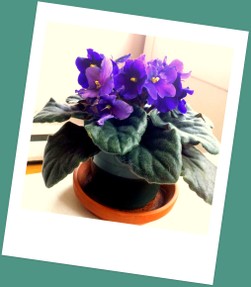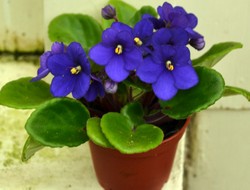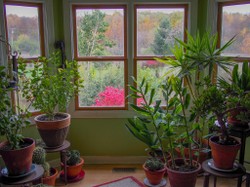When you first bring home an African violet, the odds are that it is healthy and in full bloom. Unfortunately, without proper care, this plant's delicate flowers can quickly fade and fall away, leaving you with a sad green canopy of velvety leaves the size of a Frisbee. Fortunately, there is a simple solution that will allow you to bring your plant back into full and joyful bloom without having to secretly beg or bribe the plant when no one is looking. Indeed, unlike many other house plants, African violets can bloom at any time throughout the year, providing your home with a natural pop of colour that will brighten up even the most sombre winter days.

Is Your African Violet not Flowering? 5 Easy Steps to Keep Your African Violet in Bloom
Are your African violets not flowering? These 5 steps ensure that your plant stays in bloom longer and blooms more frequently all year long.
Step 1: Proper soil, drainage and potting
Getting to the root of the problem
One important element to consider when preparing your plant to set blooms is the quality of the soil and health of the root ball. In order to ensure these things, re-pot your plant in a mixture of 1/3 each of perlite, vermiculite and peat moss. Otherwise, you can buy a pre-mixed soil that is designed for African violets for only a few dollars; I prefer Miracle Grow's African Violet Mix for my own plants. This type of mix should allow the soil to retain some moisture all the while allowing the excess water to drain out of the pot. Never pack the soil tightly as this limits the roots' ability to grow comfortably and collect water.
When selecting a pot, make sure its diameter is 1/3 the size of the rosette (i.e. 1/3 the width of the African violet). Choosing a pot that is too big will delay blooming as African violets enjoy being pot-bound. In other words, if the pot is too big, the plant will focus on filling the soil with roots before it concentrates its energy on producing flowers. An easy fix then is to choose an appropriately-sized pot.
Finally, the type of pot you choose will have an impact on the frequency at which you water your African violet. Indeed, plastic or glazed ceramic pots tend to conserve water, while unglazed clay pots allow the water to evaporate through the clay. The type of pot you ultimate choose is up to your discretion, budget and taste, but be mindful of the impact this will have the soil's humidity on any given day.
Ideal Potting Soil and Planters
 | Miracle-Gro 0044607-323 African Violet Potting Mix - 8 Quart Specially formulated for African Violets with a slightly acidic pH, Miracle-Gro African Violet Potting Mix is a premium blend of sphagnum peat moss and perlite. Improves existin... |
 | Talavera African Violet Planter Pot with Attached Saucer, Assorted Colors This is a small Talavera Planter Pot with attached Saucer measuring about 4 3/4" tall with a 6 3/4" diameter. The picture shows a typical painting style and the one you receive ... |
 | GrowAnimal Frog Planter Grow Animal self watering planters keep moisture loving plants alive and thriving with minimal attention year round--just add water to the planter's outer pot every one to three... |
 | Talavera Planter Pot with Attached Saucer, 6 1/4" x 8 1/4", Assorted Colors This is a medium Talavera Planter Pot with attached Saucer measuring about 6 1/4" tall with a 8 1/4" diameter. The picture shows several typical painting styles and the one you ... |
African Violet Fertilizer
Your violets will bloom like never before!
 | Schultz African Violet Plus Plant Food 8-14-9, 4 fl oz. 1061 Schultz 5.5 OZ African Violet Liquid Plant Food. Improves quality of all African violets and other gesneriads Helps stimulate flower production Package features helpful growing ... Only $8.19 |
 | African Violet Plant Food Good for all African Violet Varieties and all flowering houseplants. The 1-3-1 plant food has been a long time favorite of commercial African Violet growers. The high phosphorus... Only $15.99 |
 | Miracle-Gro 100052 Liquid Houseplant Food - 8 oz For all your house plant needs, Miracle-Gro's Plant Food meets the unique needs of all indoor plants and promotes beautiful results for all flowering and foliage houseplants. |
Step 2: Watering and fertilizing
Like all living things, African violets need food and water to grow
How much you water and fertilize will have a direct impact on how much your African violet blooms. Watering too much will cause the roots and/or crown to rot, and watering too little will stunt the plant and cause it to wilt. This is a tricky balance to strike as more new gardeners (and I have been guilty of this too!) tend to over-water plants. Too much watering love, however, is the number 1 reason for African violet death. Sadly, dead plants cannot produce flowers. Below you will find important instructions on how to water and fertilize adequately to ensure that your plant both survives and thrives!
In order to provide your plant with adequate moisture, it is important to know a little about its origins. African violets originate from the tropical and humid forest of Tanzania; consequently their ideal growing environment must likewise be warm and wet. Ideally, the water used should be lukewarm (not cold!) and should be given from the bottom with the aid of a coaster or tray. Alternatively, you may also wish to water the top of the soil, immediately below the lowest leaves. When watering from the top, ensure that you do not pour water directly onto the leaves themselves as this can burn the leaves if the water remains on them too long. If you do get water on the leaves, simply wipe it off with a soft cloth. Avoid moistening the crown (the small leaves in the centre) as this can contribute to crown-rot.
That being said, I have found that African violets respond better (and bloom better) if the soil is allowed to dry out a bit between watering. To test the soil's humidity level gently stick your finger into the soil -- the adequate time to water is once the top inch of soil has dried out. Another good way to know if your plant requires watering (and this may take a little bit of practice), is to lift the pot with your hands and weigh it. You will soon learn to recognize the ideal weight of the pot; if it feels too light, water it, if it is still relatively heavy, give it a few more days before watering it again.
Once you've established your watering routine, be sure to include frequent fertilizing! For profuse blooming, I recommend Miracle Gro Bloom Booster Flower Food 15-30-15, that being said I have had success (though more moderate) with basic plant food as well. For best results, fertilize at every watering using 1/3 to 1/2 of the recommended feeding amount.
Step 3: Bright, Diffuse Lighting
Light up your life!
When it comes to African violets, one thing is certain: they will not bloom unless they receive a sufficient amount of light. It comes as no surprise then that a large number of African violets decorate window sills all over the world. The most successful of these are typically placed by eastern or northern windows and will receive large amounts of indirect light. This point is particularly important; too much direct light will burn and discolour the leaves, and will also cause the plant to change its shape, growing tall and deformed. If you must grow your African violet by a southern or western window, make sure you drape your windows with soft, diaphanous drapes, or keep it on a shelf away from the sun's rays.
If you live in a northern area where sunlight is scarce in the winter months, you can either opt to have your plant slow down its growth throughout the winter months (as it will do naturally), or you can stimulate blooms with the aid of artificial light. Regular, incandescent or energy-efficient bulbs do not provide a full spectrum of light required for proper plant care and are not ideal. Fluorescent plant-growing bulbs, on the other hand, tend to be inexpensive and can be purchased at a local garden store or online. If you get a chance, speak to garden centre technician in order to find out which light fixtures best suit your needs.
African Violet Essentials
Read about what the experts are saying, or offer a pretty miniature as a gift!
 | Dollhouse Miniature African Violet in Terra-Cotta Pot Handcrafted. Pot may vary. |
 | Dollhouse Miniature African Violet Basket Colorful, handcrafted clay flowers and foliage in a woven basket. 1 5/8"W x 1 5/8"H |
 | You Can Grow African Violets: The Official Guide Authorized by the African Violet Society of Amer... Have you ever killed an African violet? Kent and Joyce Stork killed their first violet too! They soon mastered the skills for growing the plant and eventually wrote for the Afri... |
 | African Violets Back to the Basics: Your Questions Answered Have you ever had a question on how to grow African violets but could not find the answer? Now your dilemma is solved and you will be able to quickly find the information for wh... |
Step 4: Plant Grooming
Getting rid of the suckers
 African violets need to be well-established before they will begin to bloom. That means they like to have full foliage and a strong root system. If you have a young seedling, expect this maturation process to take approximately one year. However, store/nursery bought plants have already achieved the necessary maturity and tend to be sold while already in bloom.
African violets need to be well-established before they will begin to bloom. That means they like to have full foliage and a strong root system. If you have a young seedling, expect this maturation process to take approximately one year. However, store/nursery bought plants have already achieved the necessary maturity and tend to be sold while already in bloom.
That being said, too many leaves can slow the blooming process. Make sure to groom your plant and remove any asymmetrical, drooping or damaged leaves. Simply snap the excess leaves at the base as required. Note: Do not remove too many! An African violet will be most inclined to send out flower buds when there are proximately three sets of full, overlapping rings of leaves (the buds will shoot out from between the largest and middle set of leaves). Therefore, be sure to keep at least 25-30 leaves (including the crown leaves) on your plant in order for the blooms to be able to successfully shoot out from within the foliage.
Another very important grooming technique is to remove suckers from your main plant before they sap too much of the plant's energy, eventually deforming and crowding out the African violet. Suckers are "baby pants" that sometimes sprout at the base of the main plant. You can identify these new plants by observing the growth of new, young leaves outside of the crown area, or you will find a tuft of asymmetrical leaves amidst the older leaves. You can remove these by gently snapping them off, or if you wish to propagate a new plant, surgically remove them using a clean, sharp x-acto knife. When doing this, make sure you cut out the infant plant while ensuring that you have captured some of the root system. Plant it into a new pot and enjoy!
Step 5: Dead-heading spent flowers for continuous growth
Off with their heads!
If you have followed the previous four steps, you will have a plant that is ready to bloom within a matter of a few weeks. Step five assumes, therefore, that you have successfully guided your plant up to and including the blooming phase.
Once your African violet has sent out its first buds and these have bloomed, it is important that you enjoy your flowers but also that you be ready to part with them once they are no longer fresh. Indeed, sending flowers out is a plant's biological way of ensuring its genetic survival, by blooming, cross-pollinating and setting seed. Dead-heading, the process of cutting off flowers once they begin to fade, interrupts seed creation and encourages the plant to send out more flowers that will attempt to complete the cycle. Dead-head frequently and you will maximize the plant's flowering cycle.
In order to dead-head, simply pinch off the spent bloom at the lowest node with your thumb and index and discard the spent flowers. It's as simple as that! You will notice new buds pushing out of the foliage again within a few days.
Make sure that you are fertilizing your plant every time you water as the blooming process uses up a lot of the plant's energy. In addition, do not forget to provide enough light, as discussed above.
Should you follow all of these steps, you should have a happy African violet that will be in bloom for the greater part of the year (African violets do take short rest breaks between bloom cycles, but if you follow steps 1 through 5, this rest period should be minimal.)
Finally, Sooneaty has done a wonderful job of keeping her African violets in bloom and shares her tips and tricks (including dead-heading) in the video posted below. Enjoy!
Excited to put your new skills to the test? Order your African violets from ebay today!
Artificial Light Fixtures
How to keep your African Violets in constant bloom Part-1.
Sooneaty takes you through her blooming tips
You might also like
Tovah Martin’s The Indestructible Houseplant: 200 Everyone Can...Tovah Martin’s The Indestructible Houseplant gives illustrative, informative ...
Book Review: Growing Healthy Houseplants, by Ellen Zachos, in ...Growing Healthy Houseplants by Ellen Zachos helps readers to choose the right...








 Green Offices and Green Homes: Three Plants that will Purify and Improve Your Indoor Air Qualityon 05/20/2012
Green Offices and Green Homes: Three Plants that will Purify and Improve Your Indoor Air Qualityon 05/20/2012
 How to Potty Train Your Cat on the Toilet - Cat Toilet Training Tutorialon 04/23/2012
How to Potty Train Your Cat on the Toilet - Cat Toilet Training Tutorialon 04/23/2012



Comments
Great information in plain English!
thanks a lot very instructive video. Lovely, from vikash mauritius.
the african violet has always been a favorite of mine/I need to get me another one! thanks for the refresher on how to care for them!
I used to keep African violets quite successfully. I even grew a new plant from a leaf. You have inspired me to go out and buy one to enjoy once more.
I love African Violets and your tips and suggestions will come in so handy and keep my plants looking their best.Thanks.
These are adorable. I know a girl who is complete nuts about violet color and great fan of violets. She'll love your photos!
Hi Stephanie, I'm glad you found this useful! You should definitely give you plant lots of light, but not much direct sunlight. Just keep in a really brightly lit room. Hope things work out!
Great info. My mother-in-law just bought me my first ever African Violet for Mother's Day. The tag said to keep it moist at ALL TIMES and to only allow 1-3 hours of sun daily. I am glad I cam across this before it was too late.
My African violet was doing great for years, other family members who received the same gift at the same time a few years back were always amazed at our constant bloomage and size. Then I dropped an air conditioner on it. It hasn't recovered yet. I think your tips are exactly what I needed to stumble onto. Really well written!
Very helpful! I have 3 sad looking plants that I'm going to treat to your tips.